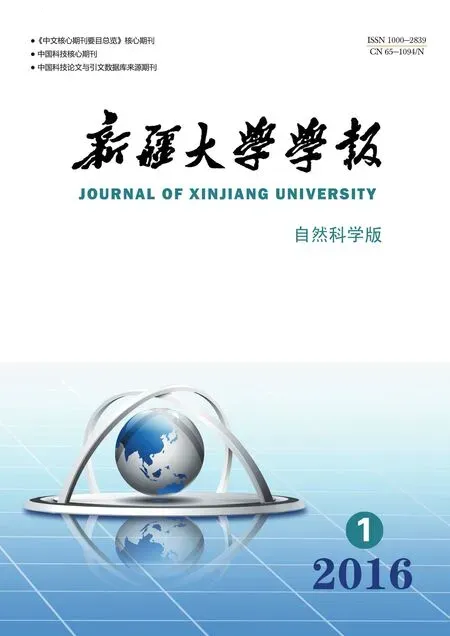Community Diversity and its Seasonal Dynamics of Soil Mites in Oasis of the Sangong River Watershed of Xinjiang,China∗
Abliz Omar,Qaken Ajar,Hajim Mukaram,WU Songlin
(College of Life Sciences and Technology,Xinjiang University,Urumqi Xinjiang 830046,China)
Abstract: Soil mites has been used as an important bio-indicator of soil ecosystem.In order to understand the community diversity and its seasonal changes of soil mites at different habitats in oasis of the Sangong River Watershed,a field investigation was conducted in April,July,September,and mid November,2011.Seven different habitats including timber forest,shelter forest,nursery garden,arable land,saline-alkali land,shrubwood,and desert grassland were chosen,and modi fied Tullgren methods was adopted to isolate the soil mites in 0-20 cm layer,with the community structure,distribution characteristics,and seasonal dynamics of soil mites analyzed.A total of 7 754 individuals were collected,belonging to 100 genera,72 family,4 orders,among which,Cultroribula and Oribatula were the dominant groups.There existed signi ficant differences in the individual number,group number,and community diversity of soil mites among the different habitats and seasons(P<0.05).In the seven habitats,the order of the Shannon diversity index was timber forest>nursery garden>shelter forest>arableland>shrubwood>desert grassland>saline-alkaline land.The spatio-temporal distribution analysis of soil mites at different habitats indicated that there was an obvious surface gathering,and the distribution had signi ficant differences among seasons and soil layers(P<0.05).The individual number was the largest in autumn,followed by in spring and winter,and the least in summer.The Jaccard similarity index of the soil mite communities at different habitats was 0.25-0.50,belonging to moderately dissimilarity.These findings suggested that there existed obvious habitat and seasonal differences in the community composition and diversity of soil mites at different habitats in the Sangong river watershed oasis ecosystem,and the climate difference,vegetation types and human disturbance were the main factors affecting the change of soil mite community diversity and seasonal.
Key words:Sangong river watershed;soil mites;diversity;seasonal dynamics
0 Introduction
Free-living mites(Acari)comprise a major part of the soil microarthropod community.They exist in all soils in land with high species richness,abundance and diversity.The alterations of natural habitats to agricultural land,plantations and pastures are among the main human activities that threaten ecosystem stability and biodiversity[1,2].Land use type signi ficantly in fluenced the abundance,richness and diversity of the soil mite communities[3−5],and the soil mites play an important biological and ecological role in the soil ecosystems,as primary decomposers of soil organics[6,7].
Thecommunitycompositionofthesoilmiteshasbeenshowntostronglytochangesinhabitatandlanduse[8,9].The abundance,distribution and community structure could show special variation at different hierarchic levels[10].The biodiversity and community structure of the soil mites have been studied frequently in many ecosystems[11,12].A number of studies have attempted to clarify the relationships among the biodiversity,the community structure of the soil mites andrelatedenvironmentalfactors[13,14].Previousstudieshaveshownthatenvironmentalfactorsaffectmitecommunities in many ways,and these factors are not independent of one another[14,15].With increasing of human activity,a better understanding of the effects of the human disturbance on soil quality and fauna on the different spatio-temperal scales is critical important to protect the biodiversity[16−20].
With increasing attention being paid to soil quality and soil health,there has been growing interest in recent years on the impact of land use on soil mite communities[21,22].Free living soil mites are abundant soil organisms that are sensitive to soil perturbations in agricultural practices and their number and diversity often get reduced affecting their ecosystem services[22].Due to anthropogenic activities the world faces potential major environmental and climatic changes.
Climatic changes will affect seasons,which have been demonstrated to affect the soil mites’abundance and diversity[22,23].The use of soil mites as indicators of soil quality and soil health may bene fit greatly from the techniques and mass of information available about soil mites under different land uses.Land change in oases has been a major concern for the Xinjiang,Northwest China.Over the past 50 years,the local vegetation and soil have been changed or modi fied by large-scale land reclamation,irrigation and cultivation,as well as the application of fertilizers across this region[24].Because of the prominent variations in groundwater,soil and vegetation,the study area can be divided into several land use types(different habitats)in which the vegetation succession is an important feature in the process of land use types.Vegetation types could in fluence soil properties due to differences in litter quality,root activity,canopy interception of atmospheric deposition,nutrient uptake and growth,as well as the diversity of the soil mites[25].To protect the fragile ecosystem and maintain a sustainable development for the oases,it is utterly important to understand the current status and trend of the land change better land-use policies and management strategies can be developed.At present,due to the lack of a research on the impact of the different land use patterns on soil mite communities,and also don’t know much about the response and the mechanism of soil mites in the different degree of human disturbance[26].However,no such studies cover the soil mites in the oasis of the Sangong river basin area in Northwest arid region of China.Considering the importance of soil mites in terms of indicating the quality and health of soil,determining the impact of the land uses on the structure of the soil mite communities and species diversity in arid land of Northwest China is now a desirable scienti fic goal.
1 Materials and methods
1.1 Description of study area
The Sangong River watershed is located in the eastern central section on the northern slope of the Tianshan Mountains and in the southern Junggar Basin(43˚450∼ 45˚300N、87˚460∼ 88˚440E),Xinjiang,China,with a total drainage area of 1 670 km2.The drainage basin consists of three physiographical units,Tian Shan mountains to the south,oasis in the middle and,to the north,the southern flank of the Gurbantonggut Desert.The oasis covers the piedmont of Tian Shan and the basin margin of the Junggar Basin with a size of about 942 km2,sloping to the north with an elevation ranging from 700 to 450 m a.s.l(above sea level)(Fig 1).Spatial variations in soil and vegetation are evident across the oasis.It is a typical oasis agriculture ecosystem of the arid region of North-western China.The oasis mainly consists of the Fubei Farm,the Liuyunhu Farm,and the district of Fukang.The Fubei Farm,developed by reclaiming a part of the desert shrubland at 50 years ago,is representative of the anthropogenic oasis in the arid region,which made the farm a perfect choice for the study.The Fubei Farm,spread over approximately 187 km2,shares its border with the Gurbantunggut desert.The climate is inland arid temperate continental,the annual average temperature is 6.68◦C,precipitation is 164 mm,and potential evaporation is 1 817 mm.The soils are predominantly grey desert soils low in soil organic matter and nitrogen but high in potassium[24−26].
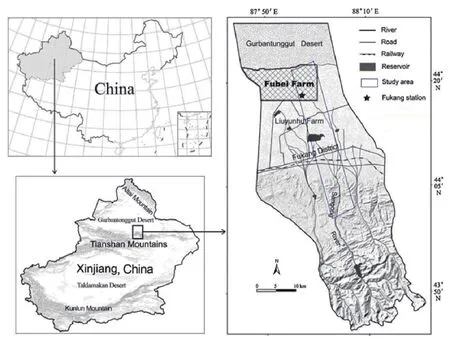
Fig 1 Sketch map of the sangong river watershed and the study area
1.2 Sample design and sampling methods
Along the oasis in the watershed of Sangong river setting two length of about 45 km habitat transects,along the transect were chosen seven different land use types(Timber forest,Shelter forest,Nursery garden,Arable land,Saline-alkali land,Shrubwood and Desert grassland),in which vegetations,environmental conditions and human disturbances were different.Each kind of habitat were selected 5 sampling points,each sampling point to remove the surface coverage,and 0∼5 cm,5∼10 cm,10∼15 cm and 15∼20 cm soil layers continuously strati fied sampling by soil sampler 100 cm3respectively in four seasons in 2011(a total of 480 soil samples).Soil mites were extracted by modi fied Berlese-Tullgren method for 48∼72h.Soil mites were collected from the samples using a stereomicroscope and stored in 75%alcohol until identi fication.Subsequently,specimens were mounted on temporary microscopic slides with lactic acid and identi fied using a light microscope to genus level following Yin Wen-ying“Pictorial keys to soil animals of China ”,Jun-ichi Aoki“Pictorial keys to soil animals of Japan”,Shozo EHARA“Illustrations of the Mites and Ticks of Japan”、Balogh J&Balogh P “The Oribatid Mites Genera of the World”and Krantz GWet al.“A Manual of Acarology.Third Ed.”to classi fication,identi fication and quantitative statistics of soil mites[27−32].
1.3 Determination of the main environmental factors
At the same time in the survey of soil mites,the determination of the main environmental factors in the samplings(including soil bulk density,temperature,moisture,pH value and organic matter).Soil bulk density using the soil cutting ring method;soil temperature and soil pH using geothermometer and soil acidity meter;soil moisture using the drying method(GB 717-1987)=(G1-G2)(wet weight-dry weight)/G 2*100%.Determination of soil organic matter content using Potassium dichromate sulfuric acid solution and oxidation with(GB 9834-1988).
1.4 Data analysis
The number of individuals and biodiversity indices at different habitats were compared by a one-way ANOVA.Post hoc comparisons of means were done using the Duncan test at α=0.05.The PCA(Principal Component Analysis)method was used to evaluate descriptive indices of community characteristics.The Shannon-Wiener diversity index is de fined as:
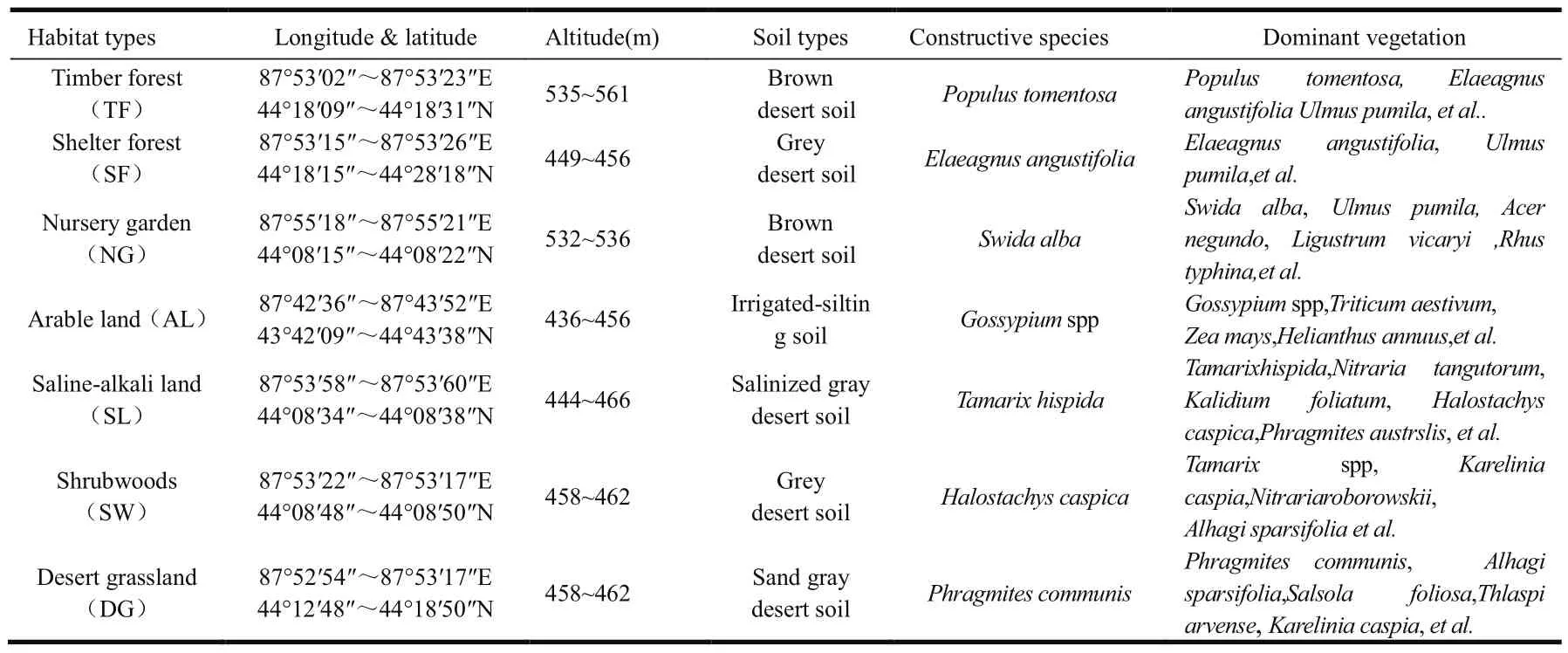
Table 1 Natural conditions of the different habitat types in the oasis of the Sangong river watershed
(1)Shannon-Wiener diversity index(Shannon&Wiener,1949)():

WhereSis the total number of species andPiis the abundance rate of the number of i species.
(2)Pielou evenness index(E):

WhereHis the diversity index of the community,andSis the number of groups.
(3)Simpson dominance index(C):

(4)Margalef abundance index(M):

WhereSis the number of groups andNis the total number of individuals.
(5)Jaccard similarity index(q):

Where,cis the number of species common to the two sites,athe number of species found in the first site andb,the number of species collected in the second site.
(6)Euclidean distance ED:

Whereijis the ecological distance between samplesiandj,ikis the abundance of species k on samplei,and there are s species.
2 Results and Analysis
2.1 Changes in the composition and number of soil mites at different habitats
A total of 480 soil samples collected,in which a total of 7 754 individuals were captured,which belonged to 4 orders,72 families,and 100 genera.Among them,5 171 individuals of Oribatida,which belonged to 44 families,66 genera,and accounted for 66.7%of the total individuals.1 727 individuals of Mesostigmata,which belonged to 13 families,15 genera,and accounted for 20.27%of the totals.850 individuals of Prostigmata,which belonged to 14 families,18 genera,and accounted for 10.96%of the total mites.5 individuals of Astigmata,which belonged to 1 families,1 genera,and accounted for 0.06%of the total collections(Table 2).Notes:+++Dominant group>10%of total individual number;++Frequent group,the number of individual is between 10%and 1%of total individual number;+Rare group,the number of individual is less than 1%of total individual number.
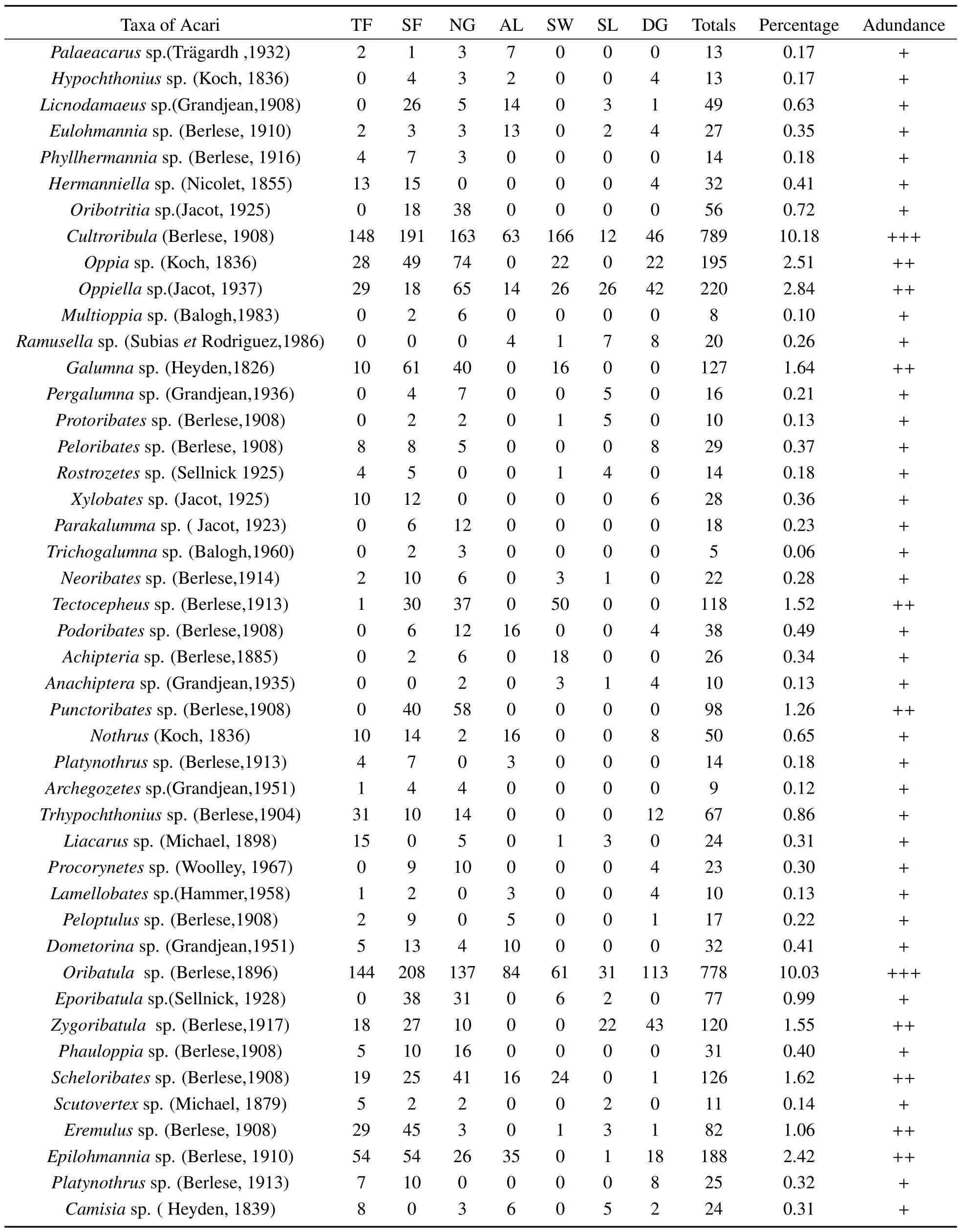
Table 2 Composition and number of soil mite communities at the different habitats in the oasis of Sangong river watershed
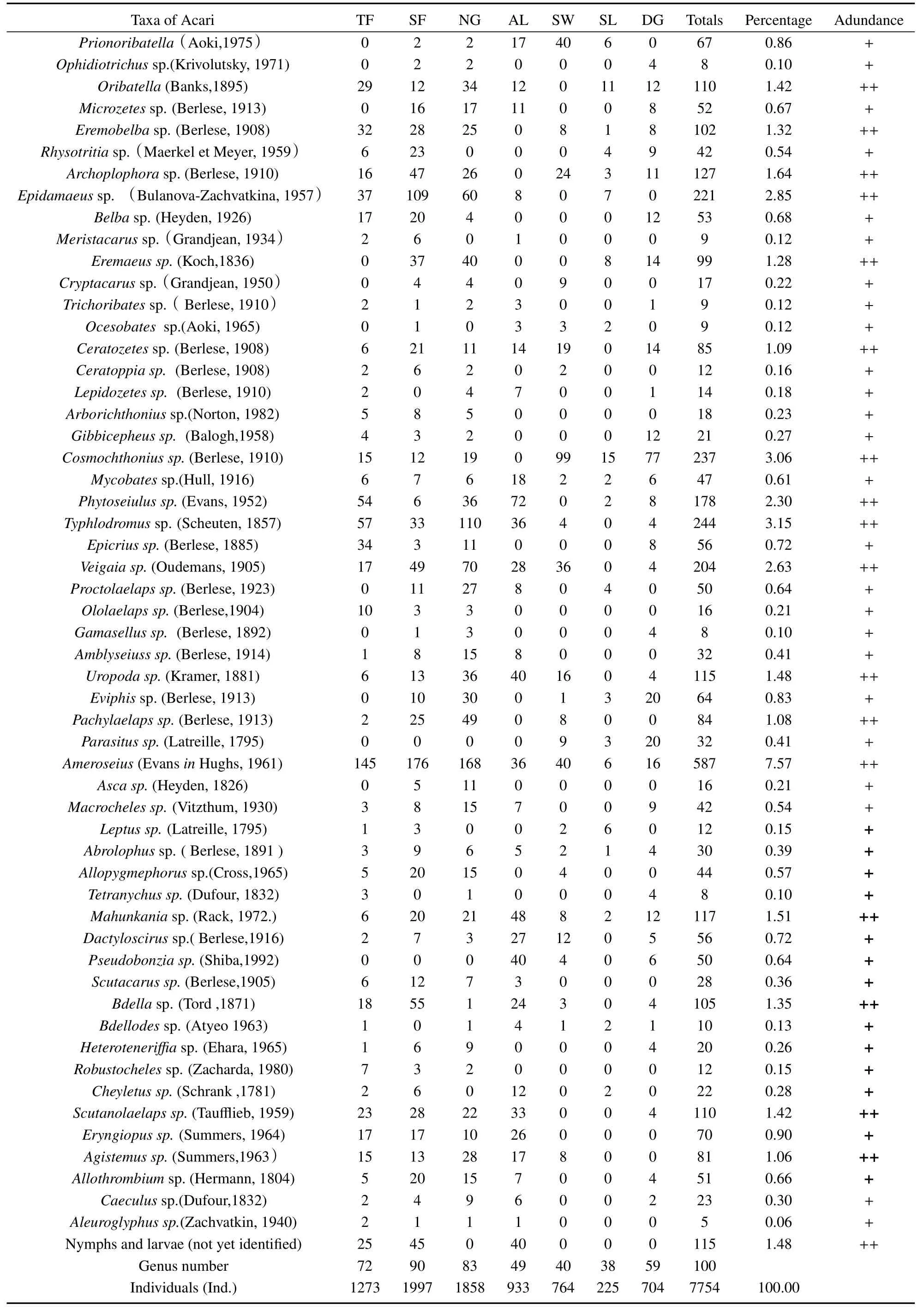
Table 2 Composition and number of soil mite communities at the different habitats in the oasis of Sangong river watershed
The most abundant genera(individuals>10%)wereCultroribula(789 individuals,10.18%)andOribatula(778 individuals,10.03%).The other common genera(1%∼10%)includedAmeroseius(7.57%),Typhlodromus(3.15),Cosmochthonius(3.06%),Epidamaeus(2.85%),Oppiella(2.84%),Veigaia(2.63%),Oppia(2.51%),Epilohmannia(2.42%),Phytoseiulus(2.30%),Tectocepheus(1.52%),Archoplophora(1.64%),Scheloribates(1.62%),Zygoribatula(1.55%),Mahunkania(1.51%),Uropoda(1.48%),Oribatella(1.42%),Bdella(1.35%),Eremobelba(1.32%),Eremaeus(1.28%),Punctoribates(1.26%),Ceratozetes(1.09%),Scutanolaelaps(1.42%),Pachylaelaps(1.08%),Eremulus(1.06%),Agistemus(1.06%).The other 69 genera were belonged to the rare groups.These data indicated that the studied area has a few dominant genera and many common and rare ones.
In general,taxa with greater abundance were also more widely distribution,CultroribulaandOribatula,the most widespread genus,were recorded in all seven surveyed habitats.Ameroseius,Typhlodromus,Cosmochthonius,Epidamaeus,Oppiella,Oppia,Epilohmannia,Tectocepheus,Scheloribates,ZygoribatulaandOribatellawere also very common and occurred in five or six sites.
2.2 The spatio-temperal variation of the soil mite communities at the different habitats
The horizontal distributional analysis indicated that there were not only signi ficant differences(p<0.05)between the amount and composition of soil mite communities in the seven different habitats,but also great differences exist in the dominant groups,common groups and rare groups.Among which the number of individuals and groups in SF was highest,secondly NG,and the lowest in the SL and DG habitats.The more conducive to a variety of the soil mites survival in the shelter forest and nursery garden in which have a good soil environment conditions such as the high vegetation cover rate and interference to a lesser degree.
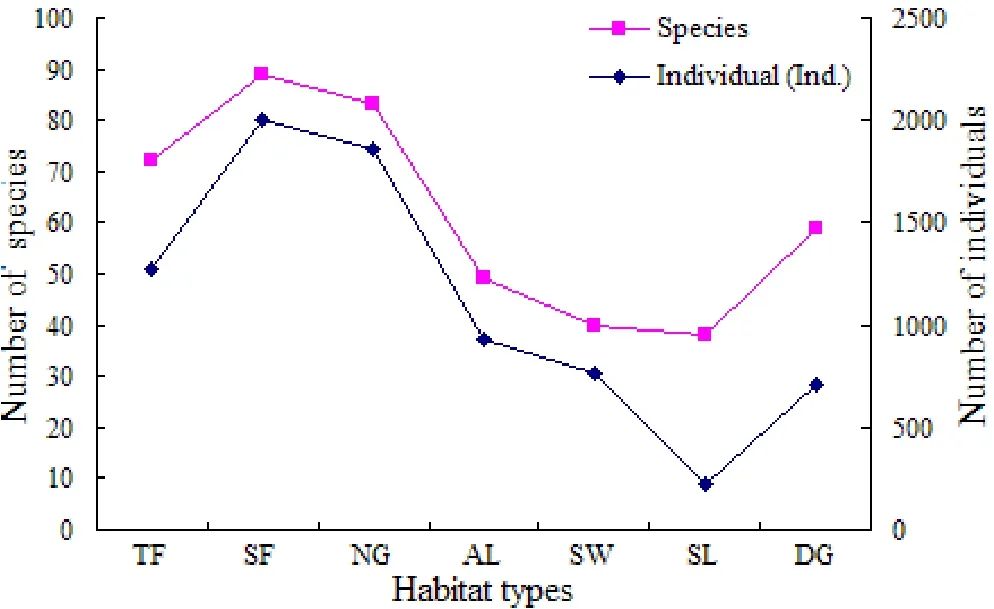
Fig 2 Horizontal variation of the soil mite communities at the different habitats in the oasis of Sangong river watershed
During the investigation,the vertical distribution of the composition and quantity of soil mite communities in the seven different habitats has obvious surface accumulation characteristics,regardless of the number of individuals or groups in different soil layer had signi ficant difference(p<0.05),from the surface to down,with the increase of depth the numbers of soil mites and individuals to gradually reduced.The upper(0∼5 cm)was the largest number of individuals,the middle(5∼10 cm)and(10∼15 cm)was lower,while the bottom(15∼20 cm)at least( fig 2).The surface accumulation characteristics could explain the soil environment quality.
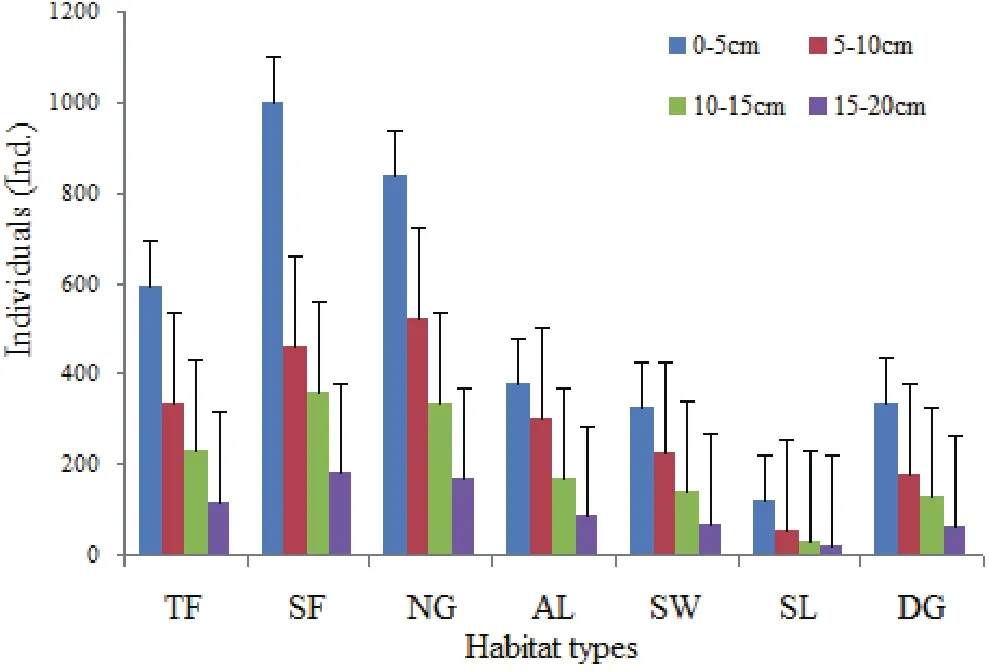
Fig 3 Vertical distribution of the soil mite communities at the different habitats in the oasis of Sangong river watershed
2.3 Diversity analysis of the soil mite communities at the different habitats
Shannon-Wiener diversity index(H)is most widely used in many index to characterize the community diversity,then often used for the comparative analysis of the diversity of soil animal community.In this paper,we also use the Shannon-Wiener diversity index(H),Pielou evenness index(E),Simpson dominance index(C)and Margalef(M)abundance index to compared and analyzed of soil mite community diversity in the seven different habitats in the studied area( fig 5 and Table 5).The Shannon-Wiener diversity index(H)and the number of individuals were highest on the SF(1 997 individuals).Both the abundance and diversity index were the lowest in SL habitat.There existed signi ficant differences in the community diversity indices of soil mites among the different habitats and seasons(P<0.05).In the seven habitats,the order of the Shannon diversity index was timber forest>nursery garden>shelter forest>arableland>shrubwood>desert grassland>saline-alkaline land.
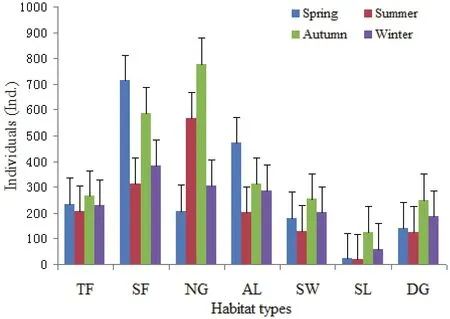
Fig 4 Seasonal changes of soil mites at different habitats in the oasis of Sangong river watershed
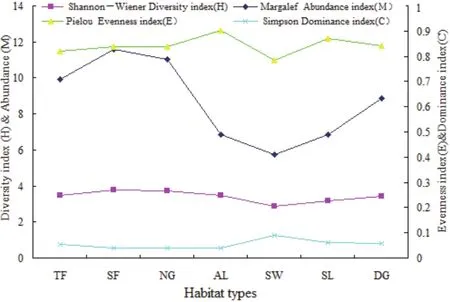
Fig5 Diversityindices of the soil mite communities at the different habitats in the oasis of Sangong river watershed

Table 3 Comparison of vertical distribution of the soil mite communities at the different habitats in the oasis of the Sangong river watershed

Table 4 Comparison of seasonal variation of density of the soil mite communities at different habitats in the oasis of the Sangong river watershed
2.4 Similarity analysis of the soil mite communities at the different habitats
Similarity analysis of the community is based on the sample survey data processing,and according to the results of the data processing to judge the similarity between the two communities.In order to similarity comparison the soil mite communities between different habitats,we use the Jaccard similarity index(q)analyzed the degree of similarity between the communities,get half matrix table(Table 5)from based on metadata of the soil mite communities at different habitats.

Table 5 Comparison of diversity indices of the soil mite communities at the different habitats in the oasis of the Sangong river watershed

Table 6 Jaccard similarity indices of the soil mite communities at the different habitats in the oasis of the Sangong river watershed
The similarity between the TF and SF habitat,NG habitat,DG habitat,SF and NG habitat,DG habitat,NG and AL habitat,DG habitat for moderately similarity(in 0.50∼0.75);The similarity in TF habitat,SW habitat,SL habitat,SF and AL habitat,SW habitat,SL habitat,NG and SW habitat,SL habitat,AL and SW habitat,SL habitat,DG habitat,SL and SW habitat,DG habitat,SW and DG habitat were dissimilar(in0.25q<0.50).
2.5 Similarity analysis of the soil mite communities at the different habitats
Using the hierarchical cluster and MDS with SPSS,the seven different habitats could be classi fied into four types(Fig.6&Fig.7).
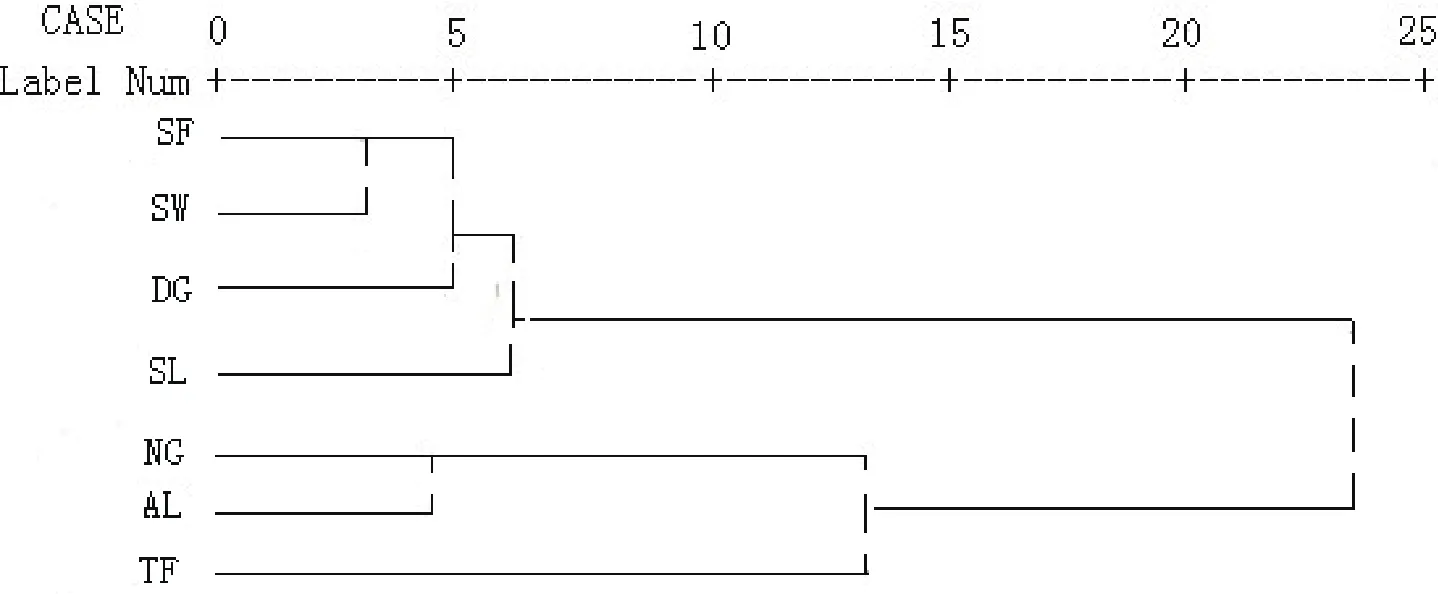
Fig 6 Cluster analysis dendrogram of soil mite communities at the different habitats in the oasis of the Sangong river watershed
The dendrogram and cluster analysis suggested that the soli mite communities of the seven habitats belonged to different types.According to the resulting of the cluster and ranking,the communities of the seven habitats could be divided into four types.Type A in shelter forest and shrubwood,Type B in nursery garden and arableland,Type C in desert grassland and saline alkali land,Type D in timber forest.
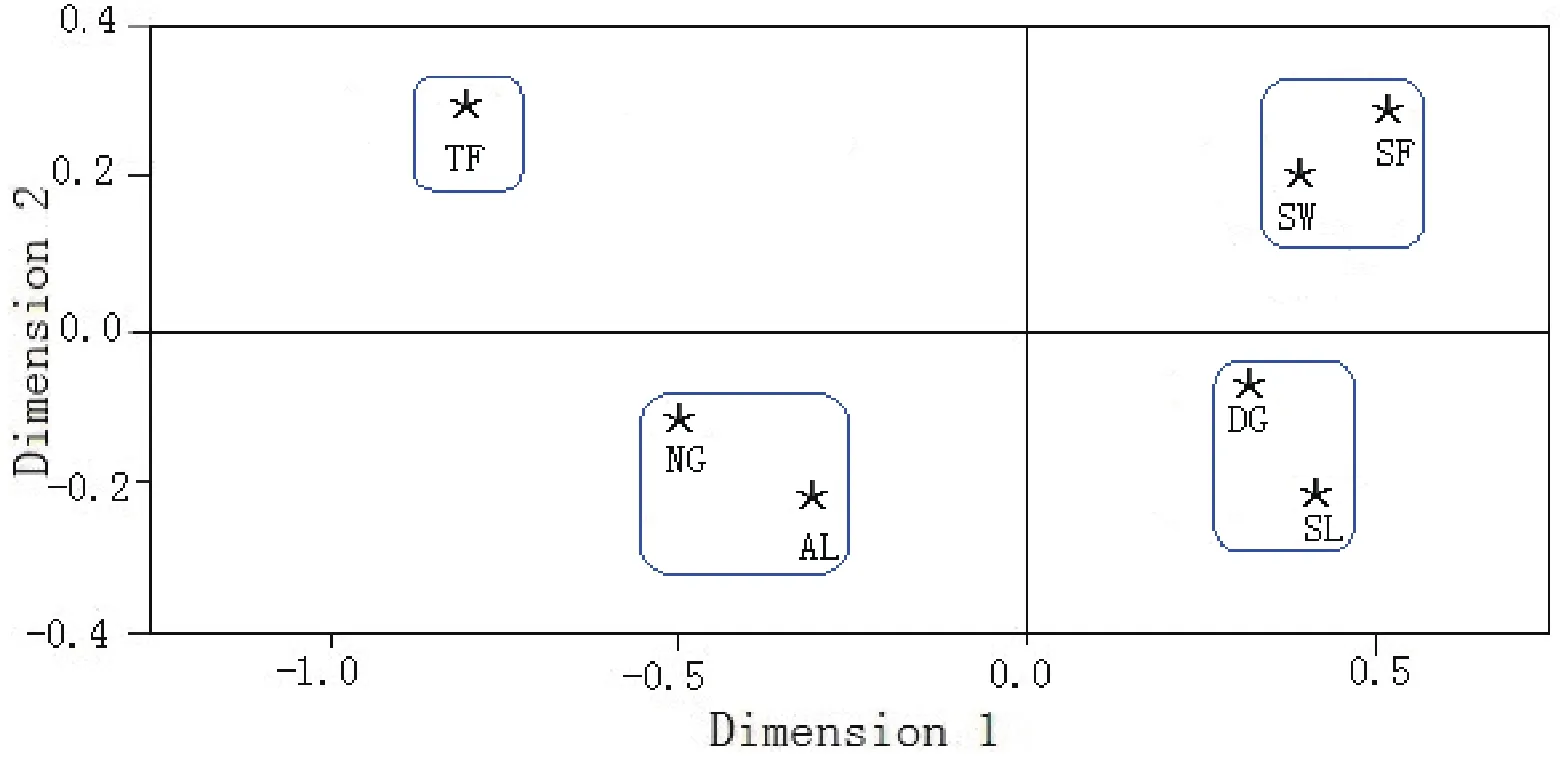
Fig 7 The two-dimensional MDS ordinal con figuration of soil mites in the oasis of the Sangong river watershed(Stress=0.17584,RSQ=0.82416)
2.6 The relationship between the soil environmental factors and soil mite communities
The five environmental factors in the seven different habitats measured results in table 6.The soil nutrient and moisture,which great in fluence on the number of individuals and composition of soil mites,and the community of soil mites was positively correlated,whereas pH and temperature were negatively correlated with community of soil mites.

Table 7 The soil physico-chemical properties at the different habitats in the oasis of the Sangong river watershed(mean±SD,April,topsoil)

Table 8 The correlation coefficient of soil physico-chemical properties and soil mite densities at the different habitats in the oasis of the Sangong river watershed(April,topsoil)
We can see from table 7&8,results of the present paper showed that soil nitrogen is an important effective factor on presence of soil acarifauna although other factors,including moisture,litter type and quality,were also effective on abundance and biomass of soil habitants.A higher organic matter content provides a food source for soil fauna and along with higher clay content and good soil structure would create a suitable environment for most soil acarifauna.Bulk density has great in fluence on the vertical distribution of soil acarifaunal community,bulk density of small,loose soil,there were more of groups and individuals of soil mites.With the increase of soil depth,the soil bulk density increased,the number of groups and individuals of soil mites decreased in the same soil plots.Temperature also has certain impact on the composition and number of soil mite communities,composition and individuals of soil mites were reduced at higher soil temperature(≤27.8◦C),whereas they will be increased in soil temperature about 23∼25◦C in the environment.Soil moisture is one of the key factors of the composition and quantity distribution of soil mite species,composition of soil mites were more in soil with high water content in the community,individual number of largequantity,whereasthecommunitycompositionwasscarceandindividualnumberdecreasedwhenthesoilmoisture was low,growth and reproduction of soil miteswere not conducive to soil acarifauna.Moisture was signi ficantly higher in nursery garden and arableland compared with shelter forest and desert grassland habitat,but individual number was lower than that the laters.This character was signi ficantly higher in 0∼10 cm depth than in 10∼20 cm depth.The survey results showed that soil pH value is one of the limiting factors of the distribution of soil mites,most of acarifauna suitable for living in acidic and neutral conditions,soil mite communities were more abundant in the shelter forest habitat where in pH value of 7.6,and composition and quantity of soil mite communities were less in the SL habitat in which pH value of 8.8.

Table 9 The correlation between the environmental factors with density of soil mites at different habitats in the oasis of the Sangong river watershed
3 Discussion
There were obvious differences in the compositions and the number of individuals of soil mite communities in the seven different habitats in the oasis of the Sangong river watershed.Both of number of individuals and genus were the largest in the shelter forest habitat,while at least in the saline-alkali land.The individual number of soil mites were captured in the shelter forest habitat was about 8.88 times greater than that of the saline-alkali land habitat,and 2.84 times greater than that of the desert grassland habitat,and the genus number in such habitat 2.37 times greater than that of the desert grassland habitat.The individual numbers of soil mites were sensitive to the soil humus content and humidity in the studied area,therefore,number of individuals were the largest in the shelter forest habitat in where the most suitable food resource and humidity conditions,while at least in the desert grassland habitat in which the highest surface temperature[33].The distribution of soil mites community was closely related with the vegetation,human activities[34,35],and environmental conditions in the process of human activity intensity in that area,soil mite community was more in microhabitat in which the vegetation cover higher and human disturbance a degree to a lesser,and these environmental conditions more favorable for a lot of the soil mites survival[36−38].
The number of individuals and genus,community diversity,evenness,dominance,richness and so on were an important indices to re flect the soil mites community structure,ecological function and horizontal distribution difference[39,40].The results of this study compared with other areas in China,the dominant genus and common groups were basically the same[30,31],but the community composition and quantity were different.Generally,both of the genus number and individual number in soil mite communities in the studied area were slightly greater than those of the results of northwestern China,central China,and north China region in our country[41,42].Therefore,concluded that the composition and functional groups of soil mite communities in different habitats in the oasis of Sangong river basin were relatively abundant and unique.
Theresults ofthe comprehensiveanalysis showed thattheverticaldistribution ofgenus and individualsin different habitat sampling were also following decreased with soil layer deepening tendency in overall,this phenomenon was similar to the results of most researchers[43−45].There were differences of soil mites in the different habitats due to the differencesofthecontent of soilorganicmatter,nutrients,and human disturbance as well as physicochemicalproperties and hydrothermal conditions in each layer[46].
The diversity of soil mite community in the 0∼5 cm layer were signi ficantly higher than those of the other three layers,the litter content and soil organic matter layer were thicker in most sampling area in the shelter forest,timber forest and nursery garden than that of desert grassland habitat,it may be related to the sampling region with different vegetation types and coverage and other factors,need further study.Studies have shown that soil mite communities were response to on the soil physical and chemical properties[47,48],and soil physical and chemical properties such as soil organic matter and nitrogen content also have a certain in fluence on the formation of soil mites community[49].A lot of research shows that many soil factors affect the structure of soil mites community,porosity,including physical and chemical properties of ground vegetation,soil(organic matter content,particle size,pH,moisture content etc.),human disturbance etc.Among which the climate and vegetation types were the main factors which in fluencing the composition and diversity of soil mites community in arid land of northwest China.Plants were the direct or indirect food sources of soil animal,difference of species of plant community,cover and litter can cause soil mites habitat and foodsources,thusaffectingthestructureanddiversityofsoilmitescommunity[50].Theexistinglitterfallinshelterforest and nursery garden were higher than those of saline-alkaline and desert grassland habitat,and there were signi ficant relationships between the amount of annual litterfall and the composition,diversity,uniformity of surface soil mites community[51].
In addition,composition of plant community structure can also in fluence the soil mite communities,diversity,the more complex of vegetation type,the higher degree of soil animal diversity[52].In this study shows that the community diversity was the highest in the shelter forest and timber forest habitat,while the lowest in saline-alkali land and desert grassland habitat.The reason may be the vegetation community structure in these two habitats in the relatively complex,human interference is relatively small,the diversity index of soil mite communities was the highest,while the community diversity index was the lowest in the later two habitats due to the vegetation community structure in which was relatively simple,often mowing,and human disturbance.Thus,the diversity characteristics well re flect the differences of the diversity of soil mites community in the different habitats in that oasis area,this indicated that the effects of different habitat environmental factors on the distribution of soil mites community were different ways[53,54].
The similarity index is an important index to measure the relationship between habitat and soil animal.The similarity index between the seven soil types of habitat selection of the studies area basically belongs to a moderate dissimilar(in 0.25∼0.50).
The ecological distribution of soil mites community affected by climate,vegetation,soil and other ecological factors.The were obvious characteristics and community structure of soil mites community in different climatic zone in which due to with the changes of temperature,precipitation and other ecological factors[54].All kinds of soil animal in the interaction of complex way directly or indirectly affect litter decomposition and nutrient cycling,changes in community composition and functional group is an important driving factor of ecosystem function[54,55].
When the soil environmental change,directly affects the soil animal community structure in which can only survival some taxa whose is not too sensitive to environmental changes.Studies have shown that soil animal communities were actively response to the soil physical and chemical properties,vegetation,temperature,pH,moisture,organic matter,bulk density,porosity,nitrogen content were directly affects soil animal survival,and also with a certain effect force on the formation of soil animal community[56].The study also reveals that soil mites are highly in fluenced by physico-chemical changes of the soil and they can be suitable indicators of land use intensity gradient.So soil mites community can therefore be utilized as bioindicators to assess environmental disturbance in urban ecosystem based on number of species and number of organisms present within the soil.
Obviously,the difference of the soil animal community structure showed soil quality status whether it can be consistent with the re flect to soil status of ground vegetation,soil physical and chemical properties,the contents of soil elements and other factors,whether it can be directly applied in biodiversity indicators of soil environmental quality and other problems in that region,also need to combine the atmosphere,water quality,vegetation,soil physical and chemical properties and other ecological factors by correlation analysis in the ecosystem,in order to obtain more accurate information.According to the results above we could concluded that the diversity and similarity of soil mite communities of the studies sites were obviously different with each other and which due to the impact of change in the vegetation,soil humidity as well as anthropogenic disturbances.
- 新疆大学学报(自然科学版)(中英文)的其它文章
- On the Page Number of Lexicographic Product of Paths and Cycles in Books∗
- 新疆伊犁铁列克特金矿床流体包裹体特征分析∗
- 工业企业规模、分布与区域经济增长∗
- Hartman-Wintner Theorem on the Noncommutative Hardy Spaces∗
- Laplacian Spectral Characterization of Graphs with Exactly Two Laplacian Eigenvalues Greater than Two∗
- 具有随机干扰的单种群间歇扩散模型∗

